Your Trip of a Lifetime: 12 Best tips for traveling to Italy after you retire

PRO TIP: Planning a trip of a lifetime and searching for tips for traveling to Italy after you retire? Save this article in your browser's “Italy" folder for easy reference during your trip planning. For an unparalleled experience in a historically rich city like Rome, see our private Tours of Rome. Browse our top-rated Rome Countryside Tours and Tuscany Tours from Rome, and Italy Transfer Service for the best way to explore Italy!
Buongiorno and welcome to Stefano’s RomeCabs, Rome’s top-rated company for Rome transfers and limousine tours in Italy. Since 2004, we've been offering reliable tours and transfers to tens of thousands of travelers and cruisers, catering to all age groups, and making their trips to Rome and Italy more convenient and comfortable.
The prospect of traveling to Italy is a thrilling adventure waiting to unfold at any stage of your life. What destination could be more enchanting than Italy? With its rich history, art, culture, and culinary delights, Italy promises an experience that transcends the ordinary.
In this travel blog, we delve into the best tips for senior travelers exploring Italy after retirement; from choosing convenient hotels for convenience to planning spontaneous discoveries, mastering basic Italian phrases for deeper connections, evaluating your mobility for various sightseeing activities, tips for effortless transfers and tours, and packing smartly for your trip to Italy.
12 Best tips for traveling to Italy after you retire
Discover the secrets to a post-retirement trip to Italy, where every moment is an exquisite exploration of Italy's timeless beauty as you savor the sweet life – La Dolce Vita.
1. Choose Hotels Over Apartment Rentals in Italy
When traveling to Italy, opt for staying at hotels centrally located in Italian cities instead of rental apartments in far-out neighborhoods for a worry-free stay. Most hotels are strategically located in the heart of cities or near major attractions, ensuring that you have easy access to the most iconic landmarks, cultural sites, and vibrant neighborhoods. This central positioning allows you to make the most of your time without the hassle of commuting from distant neighborhoods.
Unlike apartment rentals, hotels are designed with the comfort and convenience of guests in mind. They often offer amenities such as elevators, on-site restaurants, housekeeping, and concierge services. This makes it easier for senior travelers to stay in a foreign city, ensuring a stress-free stay.
Hotels can be hubs of social activity, providing opportunities to meet and interact with fellow travelers. Common areas, lounges, and organized events create a sociable atmosphere, enabling guests to share experiences and make new friends during their stay. Staying at apartment rentals in a residential can feel isolating.

Hotels have English-speaking staff:
Italian Hotels in tourist-heavy areas have staff who speak English. This language support can be invaluable, especially when seeking assistance, recommendations, transportation, or directions. Private apartment rentals are often owned by locals who do not speak English at all nor offer any form of assistance. You may need to rely on general printed information provided inside the apartment.
Security and Safety of staying at a hotel:
Hotels prioritize the safety and security of their guests. They typically have 24/7 front desk services and may have security measures in place. This can provide peace of mind for travelers of all ages, knowing that there is always someone available to assist in case of any issues or emergencies. If staying at an apartment rental you don’t have this benefit.
Hotels have Housekeeping Services:
Another advantage of staying in a hotel when traveling to Italy is the inclusion of housekeeping services. Travelers can enjoy a clean and well-maintained space without having to worry about daily chores. This allows more time to focus on exploration and relaxation. Sure, some apartment rentals offer daily housekeeping services, but usually at an extra fee. While hotels employ their housekeeping staff, you would not know what outside cleaning services private rentals use for cleaning services.
Breakfast and hotel restaurant convenience:
Most hotels include complimentary breakfast, and others have restaurants serving a variety of cuisines. This is particularly beneficial for those days when you prefer a quick and convenient dining option within the hotel premises. For those who consider breakfast the most important meal of the day, kickstarting your day with a generous breakfast buffet is a delightful morning ritual, providing the energy needed for your day's adventures.

Hotels offer Assistance with Special Needs:
For senior travelers with specific mobility needs or health considerations, hotels are better equipped to address these requirements. They may offer accessible rooms, ramps, elevators, and other features that ensure a comfortable and accommodating stay. Such assistance is not available at most apartment rentals, many in the historical center in older palazzi may even lack elevators.
In summary, opting for hotels over apartment rentals provides retirees with a worry-free and enjoyable travel experience in Italy. The combination of central location, professional services, and convenient amenities makes hotels a reliable choice for those looking to make the most of their retirement adventures in this captivating country.
2. Plan Ahead, but Leave Room for Spontaneity:
Planning a trip to Italy as a senior traveler involves finding the perfect balance between structured itineraries and the charm of spontaneous exploration. Here's an in-depth look at how travelers can make the most of their visit by planning ahead while leaving room for serendipity:
Research and Prioritize Destinations in Italy:
Start by researching the various attractions and destinations that Italy has to offer. From historical landmarks, museums, and monuments, to picturesque villages, create a list of places you wish to visit. Prioritize them based on your interests and preferences.
Identify the must-see locations on your list—the landmarks and attractions that are non-negotiable for your trip. By prioritizing these, you ensure that even if plans deviate and you can’t see everything on your list, you won't miss out on the highlights that drew you to Italy in the first place.
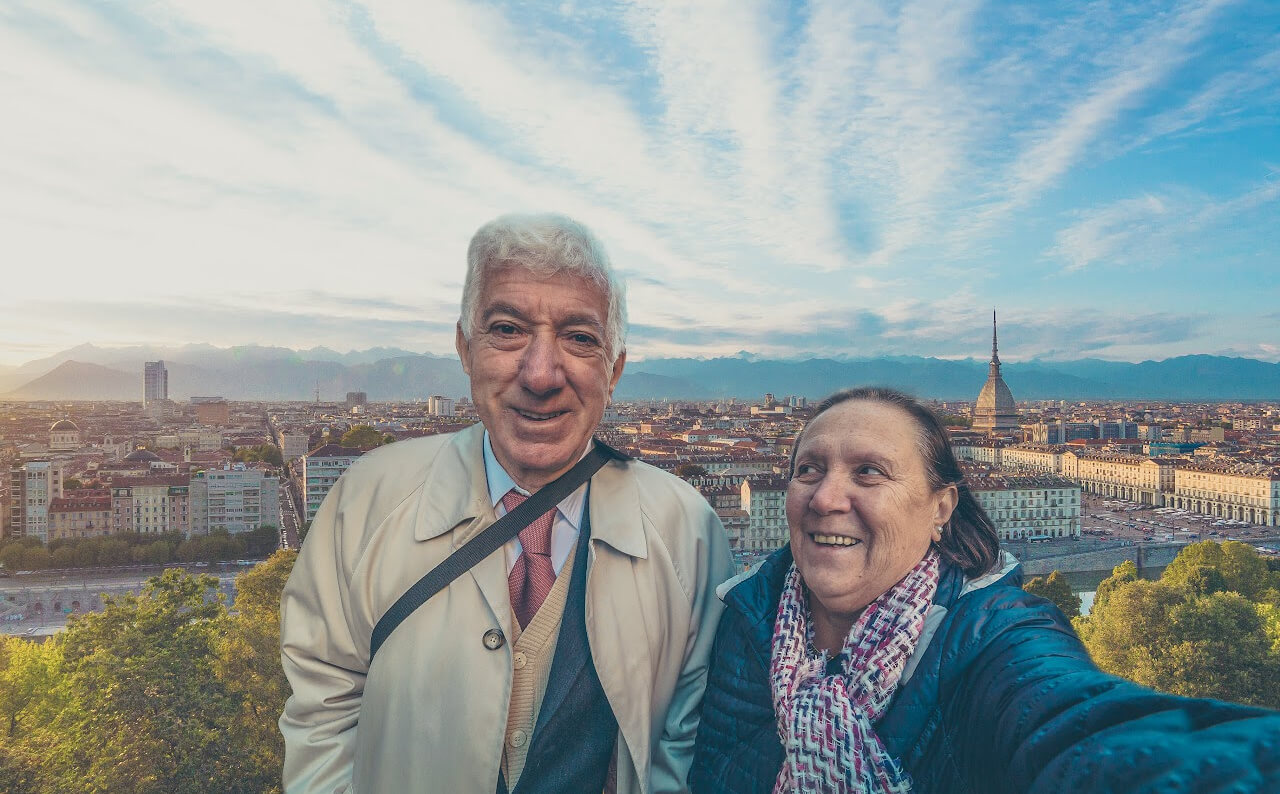
Create a Flexible Itinerary:
Plan a rough itinerary that outlines the places you want to visit each day. This provides structure to your trip and ensures that you cover the destinations on your priority list. However, allow for flexibility in your schedule to accommodate unexpected opportunities and changes.
Resist the urge to see everything in one go. By leaving some attractions or regions for future trips, you ensure that there's always something to look forward to without over-exerting yourself. Italy's diverse offerings make it a destination worth revisiting.
Consider Time and Stamina:
Recognize your personal time constraints and stamina levels. Italy is rich in history and culture, and attempting to see everything in one trip might be overwhelming. Be realistic about what you can comfortably manage each day, and factor in breaks and leisure time.
For example, touring the Colosseum and the Vatican on the same day may seem like a doable achievement, however, hours of standing and walking without suitable places to rest are challenging also for young travelers. We touch on this subject more further down in this blog.
Leave Room for Spontaneity:
Embrace the joy of unexpected discoveries by leaving gaps in your schedule. These open periods allow for impromptu strolls through narrow cobblestone streets, unplanned visits to charming local shops, leisurely stops at cafes, or just a welcomed rest. Leaving room for spontaneity adds a sense of adventure to your journey.
Be Open to Recommendations:
Locals, hotel staff, and fellow travelers can offer valuable recommendations for hidden gems and off-the-beaten-path experiences. Be open to suggestions from those you meet along the way, as they may lead you to extraordinary places not found in guidebooks.
Document Your Journey through Italy:
Keep a travel journal or use a camera to document your journey through Italy. Capture not only the planned attractions but also the spontaneous moments that make each day unique. These memories will serve as a beautiful record of your Italian adventure.
Create Lasting Memories in Italy:
Ultimately, embracing a slow pace allows travelers to create lasting memories. It's not just about ticking off a checklist of attractions but about creating a travel experience that resonates on a personal and emotional level, leaving you with cherished memories that endure long after the trip concludes. This brings us to #3 below:
3. Embrace the Slow Pace when traveling to Italy
Embracing the slow pace of life is not only a travel philosophy but a profound cultural experience, especially for senior travelers visiting Italy. Italian culture embraces a slower pace of life, and so should you.
Take Time for Cultural Appreciation:
Italy is renowned for its rich cultural heritage and traditions, and adopting a slower pace allows senior travelers to fully appreciate and immerse themselves in the local way of life while touring at their own pace (whether fast-paced or relaxed). When in experiencing Rome like a local, consider experiencing Rome like a local for an authentic experience. By savoring each moment, you gain a deeper understanding of the cultural nuances that make Italy unique.
Consider Relaxation and Rejuvenation:
Traveling at a slower pace allows for moments of relaxation and rejuvenation. Find serene spots in parks, gardens, or quiet corners of historical sites to unwind, reflect, and absorb the tranquil atmosphere, and recharge your batteries. This mindful approach contributes to a more fulfilling and rejuvenating travel experience.

Mindful Shopping:
Italy is a shopper's paradise, with markets and boutiques offering everything from handmade crafts to high-end fashion. Visiting Italy is not just about hitting as many monuments and museums as you can on your trip. Take your time browsing through local shops, appreciating the craftsmanship, and selecting meaningful souvenirs that capture the essence of your journey
4. Take Advantage of Senior Discounts
Many attractions in Italy offer senior discounts for those aged 65 and older. Take advantage of senior discounts and explore museums, historical sites, and cultural experiences at a reduced cost.
By leveraging these discounts, you not only unlock access to renowned museums and historical sites but also create room in your budget for additional enriching experiences. When you book your tickets online in advance or purchase them at the ticket counter, see if there are any price reductions for senior travelers. You may be required to show an ID as proof of your age on premises, so be sure to travel with one valid ID document.
5. Evaluate your mobility when traveling to Italy
For senior travelers embarking on a journey to Italy, evaluating mobility becomes a crucial aspect of planning to ensure a comfortable and enjoyable experience without over-exertion.
Understanding Personal Abilities:
Begin by evaluating your personal level of mobility, taking into consideration factors such as walking distance, endurance, and comfort with uneven terrain. This self-assessment is the foundation for planning an itinerary that fits your physical capabilities.
If you have mobility concerns or limitations, it's essential to recognize them early in the planning process. This may include issues with prolonged walking, navigating stairs, or discomfort on uneven surfaces. Understanding these concerns helps in tailoring the travel experience to meet individual needs.

Choosing Suitable Destinations in Italy:
Certain destinations in Italy, such as Pompeii, Ostia Antica, the Roman Forum, and ancient sites like Banditaccia Necropolis, feature uneven terrain and may require extensive walking and standing without suitable places to sit and rest. By being aware of these factors, you can choose destinations that are within your mobility level or plan accordingly with rest breaks if possible.
Navigating Cobblestone Streets in Italy:
Many cities and towns in Italy are known for their charming yet uneven cobblestone streets. Senior travelers should be prepared for this and consider it when selecting footwear and planning daily activities. Choosing comfortable, supportive shoes can significantly contribute to a more comfortable walking experience.
Accessible Accommodations:
When selecting accommodations (whether hotels in major cities, country villas in Tuscany, cozy B&Bs, or apartment rentals), prioritize hotels that offer accessibility features, such as ramps, elevators, and rooms designed for those with mobility challenges. This ensures a more comfortable and convenient stay, especially after a day of exploring.
Utilize Mobility Aids:
For travelers with specific mobility concerns, consider using mobility aids such as walking sticks, canes, or even compact travel wheelchairs. These aids can provide additional support during walks and explorations of historical sites.
When traveling with a wheelchair, it's essential to note that not all attractions may be readily accessible, but many offer alternative routes for wheelchair users. Notably, the Colosseum and Vatican Museums provide alternate elevators for wheelchair access, while Pompeii features accessible routes.
Prior to planning your visit, check the attraction's website for information on wheelchair-accessible routes and entry points. This proactive approach ensures a smoother and more accommodating experience as you explore Italy's diverse landmarks.
Prioritizing Guided Tours in Italy:
Opting for guided tours (especially with a focus on accessibility) can enhance the overall experience. Wheelchair users can enhance their visit to the Vatican and Pompeii by booking a private tour guide knowledgeable about wheelchair-accessible areas.
Evaluating mobility is a critical step for senior travelers visiting Italy. By understanding personal abilities, recognizing concerns, and planning accordingly, seniors can tailor their journey to ensure a delightful and accessible exploration of Italy's rich cultural and historical treasures.
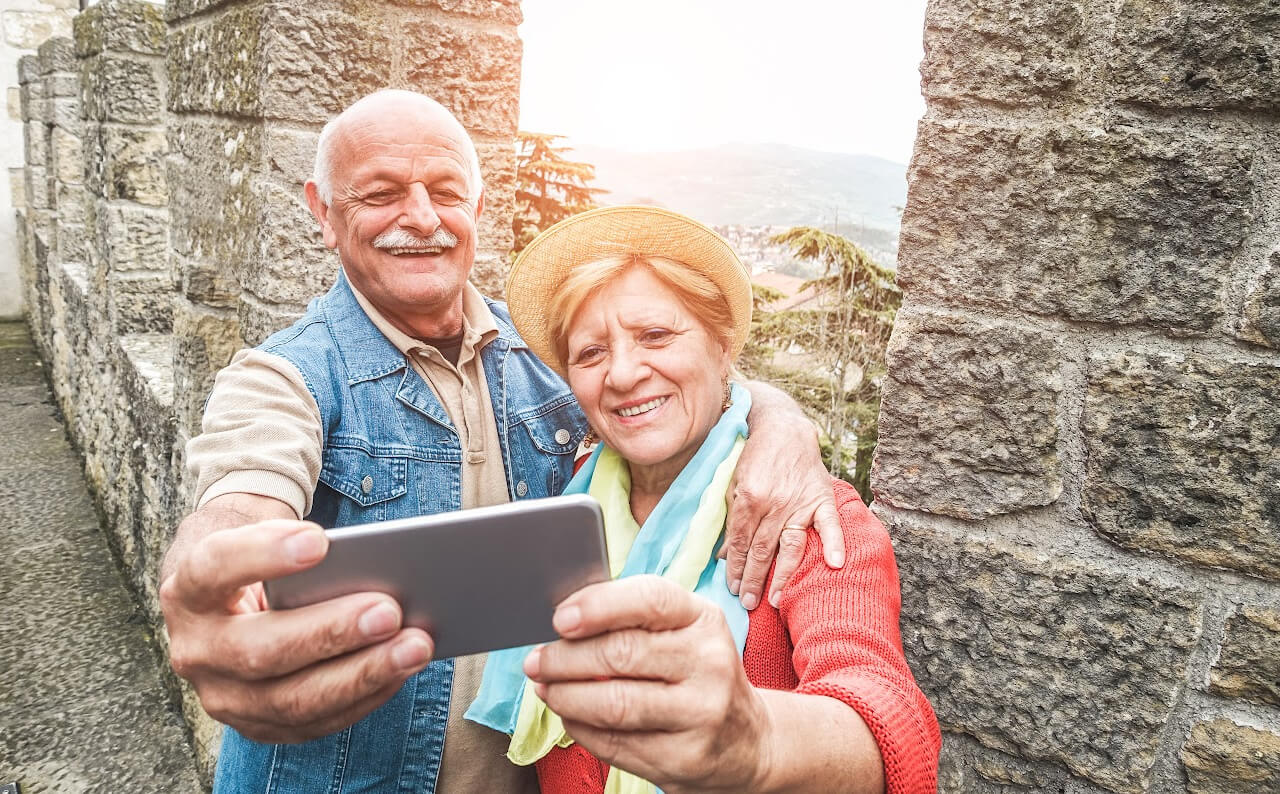
6. Book a Tour by Car to explore Italy effortlessly
For senior travelers who may have mobility concerns or prefer to minimize physical exertion, a private tour by car allows you to visit iconic sites and cities without the need for extensive walking or struggling with negotiating maps and confusing public transportation.
Private Tours by Car Minimize Physical Exertion:
Private tours are conducted in specially licensed vehicles to access city centers and to take you as close as lawfully possible to each site, minimizing walking distances. This is a significant advantage for seniors who want to conserve energy, tour at a slower pace without missing out, and reduce the physical strain associated with extensive walking and standing.
Private tours by car can often be tailored to your preferences and pace. This flexibility ensures that you can explore the sites that interest you the most without feeling rushed or exhausted.
Comfort, Safety, and Security of Private Tours by Car in Italy:
Vehicles are equipped with air conditioning and climate control, ensuring a pleasant and comfortable experience regardless of the weather. Not having to deal with crowded buses, metros, and trains reduces the risk of encountering pickpockets.
Traveling in the comfort and security of a private car contributes to a more enjoyable and safer experience touring through Italy.
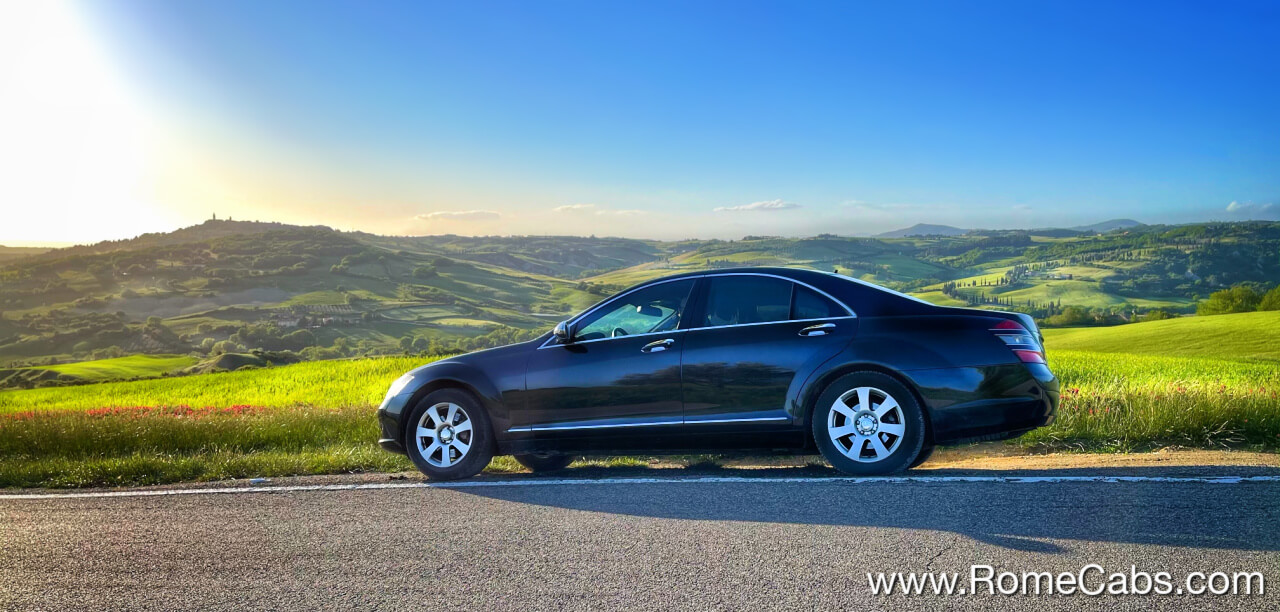
Rome Tours by Car - See More of Rome in Less Time Effortlessly
While Rome beckons exploration on foot or through public transportation, taxis, or Uber, the city demands meticulous planning, from organizing daily itineraries based on geographical proximity to studying intricate train and metro routes. Navigating the labyrinthine streets using a GPS to find your way around. It can feel overwhelming just thinking about it, let alone doing it!
Picture a scenario where you effortlessly bypass these challenges, envision seeing more sites in a single day on a Rome tour by car than independently.
Opting for a Rome tour by car makes getting around Rome with ease. Select your preferred itinerary, book the tour, and you're set! Our popular options, like the Panoramic Rome Tour and Tour Rome as Romans Do, facilitate the exploration of top must-see sites in Rome that may entail extensive walking, prove challenging by public transport, or are best reached by car. Or, book a driver for the day and tour Rome your way with a private driver at your service to take you where you wish to go!
With the day's exploration effortlessly managed, evenings can be relished at a charming trattoria, reflecting on the day's adventures in Rome, leaving you rejuvenated and eagerly anticipating your next adventure in Italy.
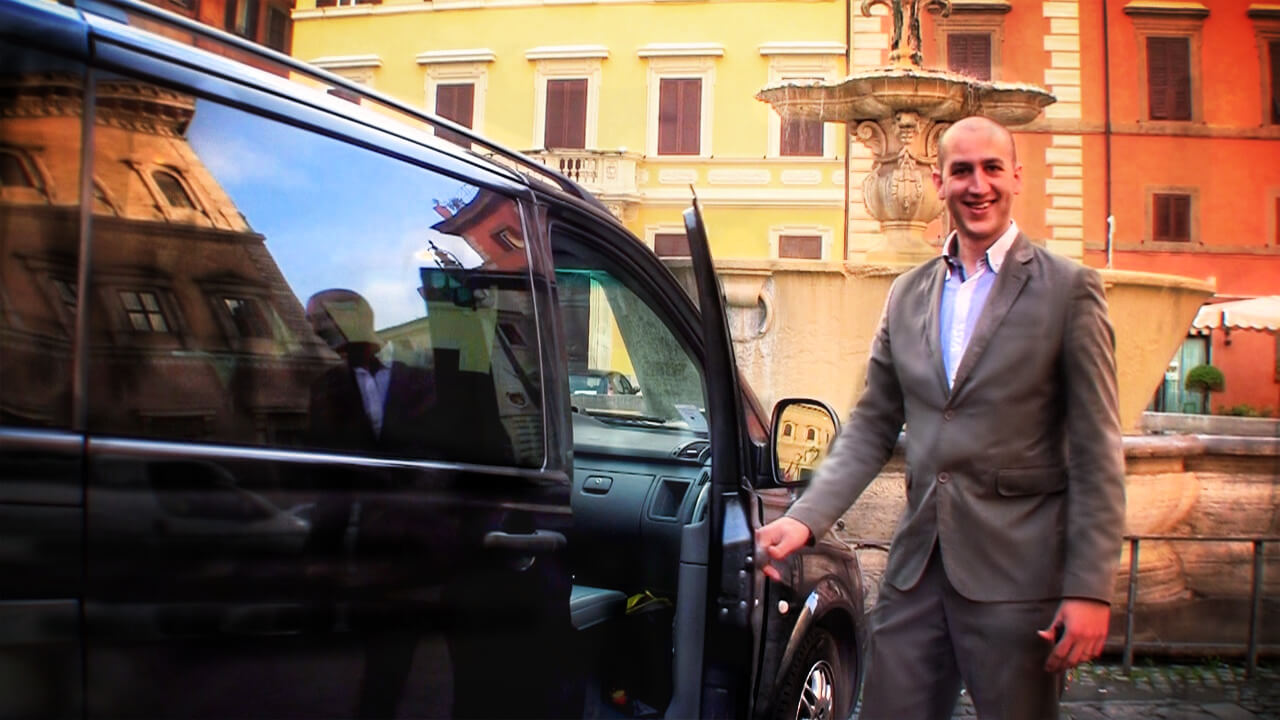
Exciting Day Tours from Rome
You can enjoy day tours from Rome to various enchanting destinations. Picture yourself meandering through the rolling hills of Tuscany on a Tuscany tour from Rome, savoring the flavors of exquisite wines at a winery, or sipping on a refreshing Limoncello on our Amalfi Coast Tour from Rome.
Uncover the hidden gems of the Italian Countryside near Rome, away from the bustling city crowds. Our private car tours from Rome to the Roman Countryside ensure that you not only visit iconic landmarks but also experience the true essence of Italy comfortably and effortlessly.
Of course, consider that some popular attractions in the countryside such as Bracciano Castle, Banditaccia Necropolis in Cerveteri, and the unique-in-the-world ancient painted tombs in Tarquinia's Etruscan Necropolis involve negotiating multiple stairs and walking on uneven terrain. As always, evaluate the sites included in tours to ensure that they align with your mobility levels.
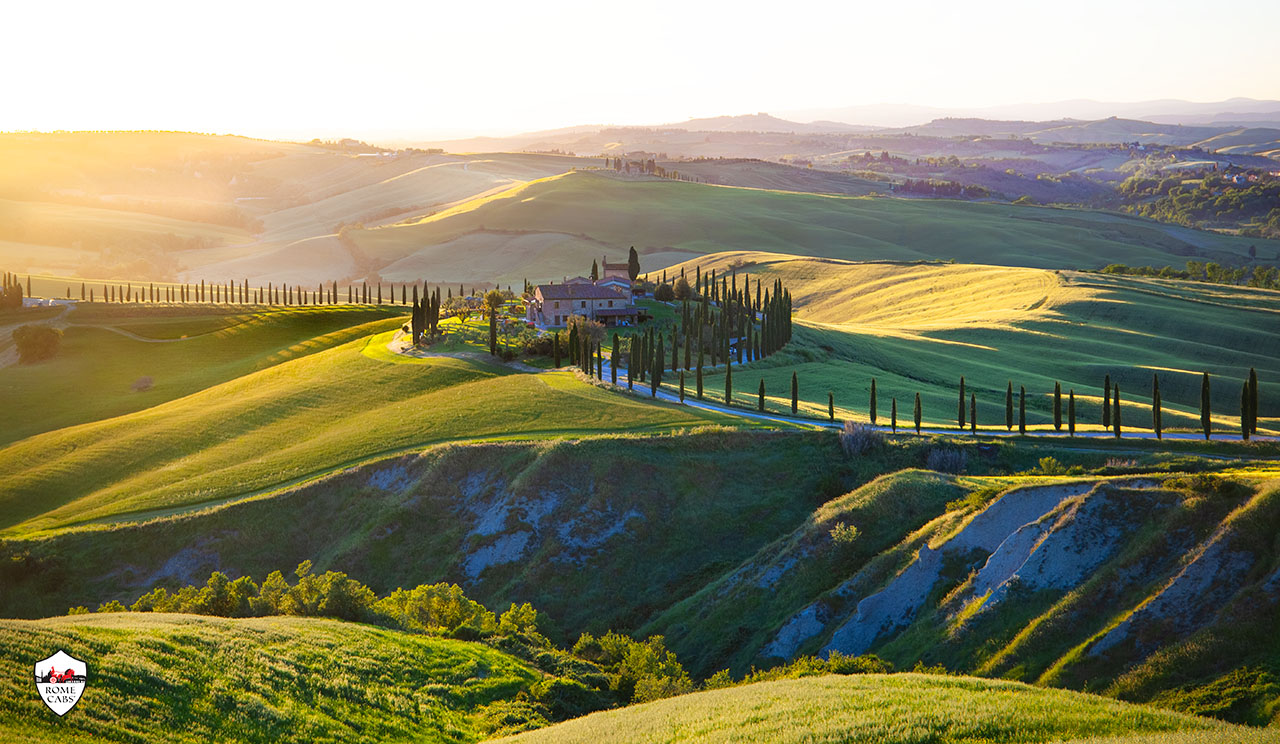
7. Use UBER to get around in Rome, Florence, and Milan safely
If staying in Rome, Florence, or Milan, utilizing Uber to get around the city can be a wise choice for travelers (young and old alike), offering distinct advantages over regular Taxis in terms of safety, transparency, and overall convenience. Uber's user-friendly app makes it easy for senior travelers to request rides, track their driver's location in real time, and receive notifications about their trip. The app's simplicity enhances the overall travel experience.
Professionally Licensed Drivers:
In Italy, Uber requires drivers to be professionally licensed, operating only in professionally licensed vehicles. This ensures that passengers are transported by qualified and authorized drivers, contributing to a safer and more regulated transportation experience.
Private Driver Service vehicles can drop you off close to attractions in Rome for ease and convenience.
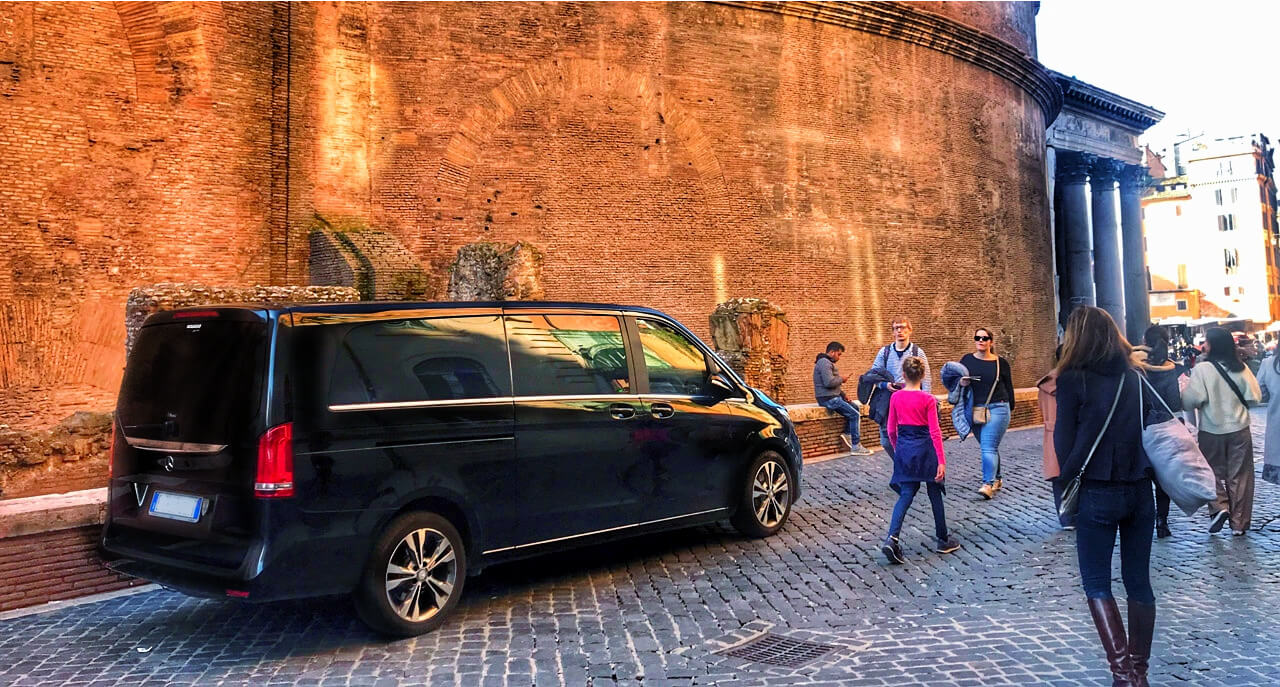
Transparent Pricing:
One of the significant benefits of using Uber is the upfront and transparent pricing. Before confirming your ride, you'll know the exact cost of the trip, which eliminates the uncertainty associated with traditional taxis that may use meters or have varying rates.
Uber transactions are cashless, reducing the need to carry and handle physical currency. This adds a layer of convenience and security, especially when compared to traditional taxis that may require cash payments.
Traditional taxis in Italy might engage in price negotiations, especially in tourist-heavy areas. Some regular taxis may pad the meter taking unsuspecting tourists for a ride. With Uber, there's no need for negotiations as the price is predetermined, providing a hassle-free and straightforward experience.
Pre-Set Routes and Safety Measures:
Uber drivers follow pre-set routes, and any deviation from these routes triggers immediate alerts to Uber. This built-in safety feature adds an extra layer of security, especially for senior travelers who may be concerned about unfamiliar routes or potential detours.
Language Barrier Mitigation:
Uber's app-based system helps overcome potential language barriers. The ride details, including destination and pickup location, are communicated through the app, reducing the reliance on verbal communication, which can be beneficial for travelers who may not be fluent in the local language.
In-App Help Center:
Uber's app includes a help center that allows users to address issues or seek assistance easily. This can be particularly helpful for travelers who may have questions or encounter challenges during their ride.
Opting for Uber in Rome, Florence, and Milan instead of Taxis can be a smart choice for senior travelers seeking a safer, more transparent, and user-friendly transportation option in these bustling Italian cities.
8. Pack Right for your trip to Italy
Packing right for a trip to Italy is crucial for senior travelers to ensure comfort, preparedness, and compliance with cultural norms.
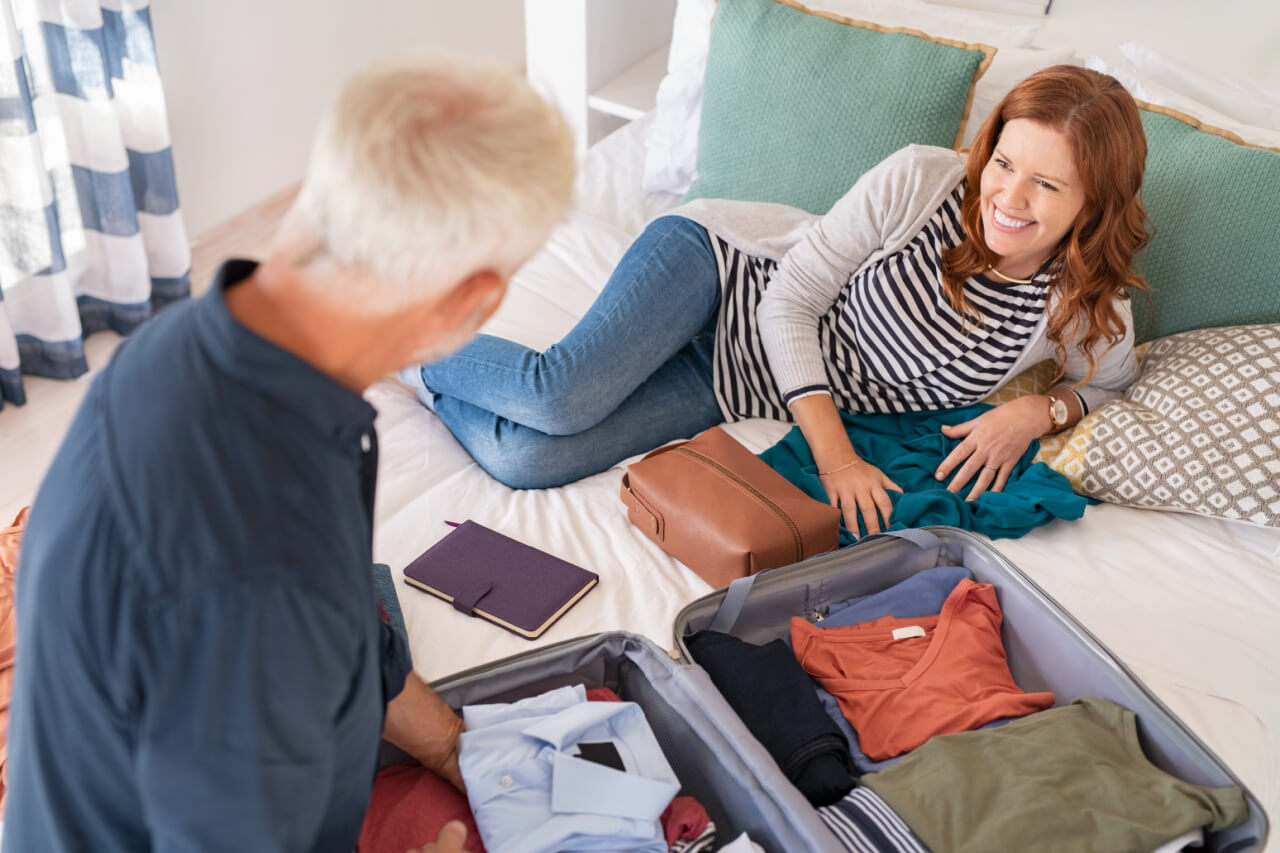
Pack Weather-Appropriate Clothing:
Check the weather forecast for your travel dates and pack accordingly. Italy experiences diverse climates, so be prepared for varying temperatures. Lightweight, breathable fabrics are advisable, especially during the warmer months. Consider packing layers for cooler evenings. Even during warmer seasons, evenings in Italy can be cool. Pack a light jacket or sweater to stay comfortable during cooler nights.
Pack Comfortable Walking Shoes to Italy:
Exploring Italy often involves walking on uneven surfaces, including cobblestone streets and historic sites. Pack comfortable, supportive walking shoes to prevent foot pain and injuries. Choose shoes that are broken in and suitable for long walks. This is particularly important for senior travelers who may be more susceptible to discomfort.
Bring Appropriate Attire for visiting Churches in Italy :
Many churches in Italy have a dress code that requires visitors to cover their shoulders and knees- especially if traveling in the summer. If you are wondering how to dress when visiting churches in Rome, Italy, be sure to pack lightweight scarves, shawls, or a jacket that you can easily drape over your shoulders when entering religious sites, and plan on wearing skirts or pants that cover the knees.
Pack your Prescription Medications:
Pack all necessary prescription medications in their original packaging. Bring an ample supply to last the duration of your trip and a little extra in case of unexpected delays. Keep a copy of your prescriptions, including the generic names of the medications. In the event of lost or stolen medication, this documentation can facilitate obtaining replacements.
Pack Over-the-Counter Medications:
Include a basic travel medical kit with over-the-counter medications for common ailments such as pain relievers, antacids, motion sickness pills, and any specific medications you may regularly use.
While you will find most over-the-counter medications in Italy (using different names in Italian) it’s always best to travel prepared so as to not have to struggle to find pharmacies with an English-speaking pharmacist or staff member to assist you.
Travel Insurance Information:
If you purchase traveler's insurance to cover health emergencies, keep a copy of your travel insurance information, including policy numbers and emergency contact details. Ensure that the insurance coverage meets your specific needs, including potential medical expenses.
Bring Adapters and Chargers:
Bring the necessary power adapters for your electronic devices. Italy uses Type C and F electrical outlets, so make sure your chargers are compatible. If traveling frequently, purchase an all-in-one adapter that can be used in multiple countries around the world. If you forget to bring one, you can find them at various shops in Italy, especially in touristy areas.
Consider a portable charger for your devices, especially if you plan on taking extended day trips where access to electrical outlets may be limited.
Pack Travel-sized Toiletries:
Pack travel-sized toiletries to save space and comply with airline regulations. Ensure you have essentials like toothpaste, sunscreen, and insect repellent.
If you forget any of these items at home, don’t worry. You can find them at any Italian pharmacy or supermarket.
Don't Forget Identification and Important Documents:
Carry a photocopy of your passport, ID, and any relevant travel documents. Keep the originals in a secure location, such as a hotel safe.
Pack Reusable Water Bottles:
Staying hydrated is essential, especially during sightseeing. Bring a reusable water bottle to refill throughout the day. In Rome, there are many public fountains with fresh, cool, drinkable water.
Carry a lightweight daypack for excursions and day trips. This can be useful for carrying essentials such as water, snacks, a map, and any items you pick up along the way.
By packing thoughtfully and considering the unique aspects of travel in Italy, senior travelers can ensure a comfortable and enjoyable experience while exploring the beauty and culture of this captivating country.
9. Stay Safe and Be aware of Pickpockets
For senior travelers visiting Italy, staying safe and being aware of pickpockets is crucial to ensuring a worry-free and enjoyable experience.
Stay Informed About Local Scams:
Research common scams in the area you're visiting and stay informed about the tactics used by pickpockets. Awareness is key to prevention.
Choose the Right Bag:
Opt for an over-the-shoulder bag with a secure closure. Crossbody bags are preferable as they are harder for pickpockets to grab and run. Consider anti-theft bags with features like slash-proof straps and RFID-blocking compartments for added security.
Keep your bag zipped and close to your body, preferably in front of you. Avoid hanging it loosely on your shoulder. Consider using a money belt or hidden pouch for essential documents, such as passports, credit cards, and extra cash.
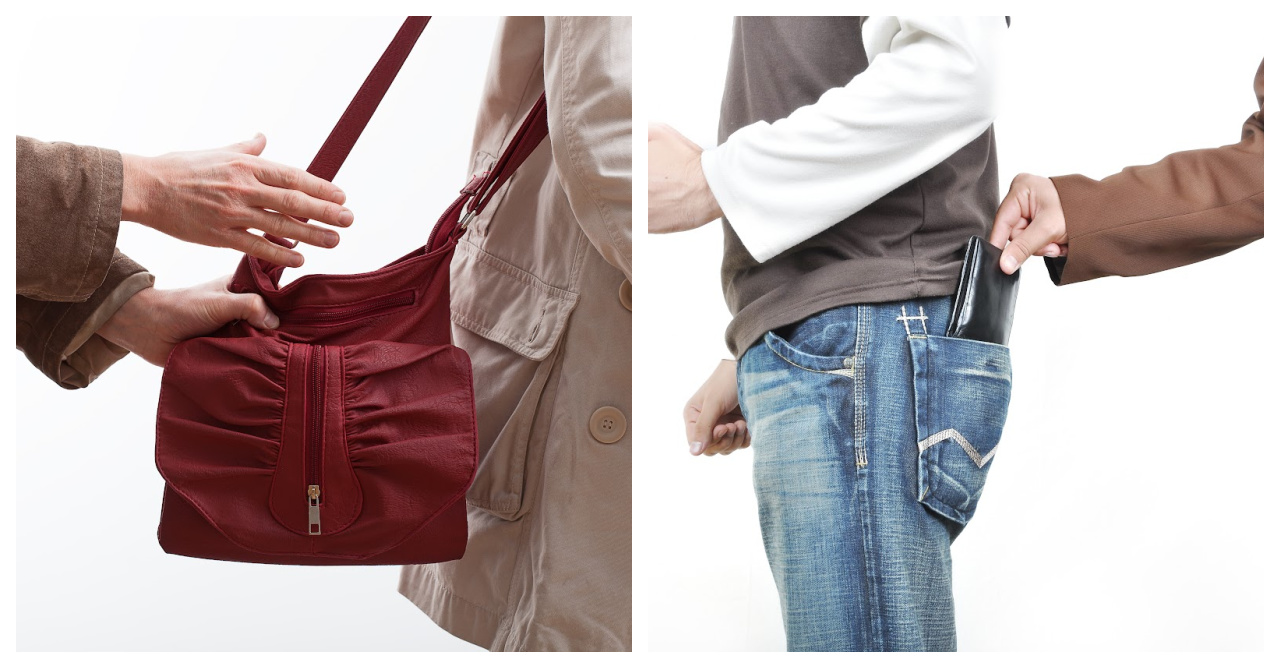
Use Caution with ATMs:
When withdrawing money from ATMs, choose well-lit and secure locations. Be discreet and shield your PIN while entering it. ATM machines within airport terminals, specifically in areas secured by checkpoints, provide a safe location for transactions.
Keep cash in multiple locations, such as a money belt or different pockets, to minimize loss in case of theft. Also, keep some of your money hidden in your hotel’s safe box or in a locked suitcase.
Minimize Expensive Jewelry and Valuables:
Leave expensive jewelry, including watches, at home. Wearing flashy or valuable items can attract the wrong kind of attention. When packing your jewelry, consider more modest pieces that are less likely to draw attention.
Don’t dangle your camera around your neck or walk around with it in your hand which can be easily snatched by a thief. Carry your camera in a camera bag (or similar) with a cross-body strap for security.
Be Cautious in Crowded Areas:
Stay vigilant in busy tourist areas such as squares and ticket lines, crowded markets, or busy pedestrian streets. These locations are often hotspots for pickpocket activity.
Don’t hang your purse or day bag on your chair at restaurants or cafes (especially with outdoor seating). Keep your bags and purses on your person at all times.
Be Mindful in Public Transportation:
Public transportation, including buses and metros, can be prime locations for pickpocketing. Stay vigilant, especially during boarding and exiting.
Politely Decline Street Vendors:
Street vendors, especially those offering unsolicited gifts like roses or bracelets, can be a distraction used by pickpockets. Alternatively, these “vendors” will offer free gifts only to ask for money as soon as you accept. Politely decline their offers by saying "No Grazie" (No Thank You) and continue walking away without engaging further.
Avoid Distractions in public areas:
Be aware of your surroundings and avoid getting distracted by street performances or overly friendly strangers. Pickpockets may use such distractions to take advantage of unsuspecting tourists.
Carry with you Emergency Information:
Carry a card with emergency contact information, including the address and phone number of your accommodation, in case you need assistance.
By being proactive, staying vigilant, and following these safety tips, you can significantly reduce the risk of falling victim to pickpockets and enjoy your time exploring any country you visit with peace of mind.
10. Bring sufficient EUROS to Italy
Bringing sufficient Euros and managing financial resources wisely is essential for travelers visiting Italy. Before departing for Italy, exchange a sufficient amount of your home currency for Euros. Consider doing this at your local bank or a reputable currency exchange service to secure favorable rates.

While credit cards are widely accepted in many places, having cash on hand is essential for small purchases that are below what can be paid with credit cards, cafes, and markets. Taxis in Italy may not accept credit cards. Have enough Euros to cover potential taxi fares, especially when arriving at airports or train stations.
Ensure you have a mix of small and large denominations for convenience. Consider using a hidden money pouch or belt to carry a portion of your cash securely. This provides an extra layer of protection against theft, especially in crowded areas.
Keep a separate stash of Euros in your hotel room as an emergency fund. This can be useful in case your primary wallet is lost or stolen. Use the hotel safe for added security.
Utilize ATMs in Italy for additional cash withdrawals if needed. You can also use the ATM machines safely and conveniently at the airport such as at Fiumicino Airport.
Prioritize Credit Cards with No Foreign Transaction Fees:
Prioritize using credit cards that do not charge foreign transaction fees to save on additional costs. Notify your credit card company and bank about your travel dates and destinations. This prevents the inconvenience of having your cards blocked due to unusual activity.
11. Book Airport and Cruise Port Transfers for hassle-free transportation
Booking airport or cruise port transfers is a savvy move for all travelers visiting Italy, providing a seamless and stress-free transportation experience.

Avoid the Hassle of Public Transportation in Italy:
Navigating busy airports, train stations, and unfamiliar public transportation systems can be challenging, especially with luggage. Booking transfers in advance eliminates the stress of figuring out routes, schedules, and potential language barriers. Transfer services often provide professional and local drivers who are familiar with the area.
Knowing that your transportation is arranged in advance provides peace of mind, especially after a long flight or cruise. You can relax and focus on enjoying your trip without the added stress of navigating public transportation or finding a taxi.
Many transfer services offer customized solutions based on your specific needs. Whether you're traveling alone, with a group, or have unique requirements, these services can tailor the transportation experience to suit your preferences.
Pre-booked transfers are generally punctual and reliable. This is crucial for meeting tight schedules, such as catching a flight or embarkation on a cruise. It reduces the risk of delays and ensures you reach your destination on time.
Contrary to common belief, pre-booked transfers can be cost-effective, especially when compared to unexpected expenses that may arise with last-minute transportation arrangements or missing your flight or your cruise due to public transportation delays or transportation strikes.
Luggage Assistance when booking Transfers:
Transfer services offer assistance with luggage into and out of the vehicle for a hands-free door-to-door service, making the journey to or from the airport or cruise port more comfortable for senior travelers who may require extra support.
Civitavecchia Port Transfers for Cruise Travelers:
If cruising from Civitavecchia port, booking transfers in advance is essential. This guarantees a timely and safe transfer from the port to your hotel in Rome or to the airport. It eliminates uncertainties and ensures you start or end your cruise journey with ease.
For all travelers and cruisers, booking airport or cruise port transfers in advance is a practical investment in convenience, comfort, and peace of mind. It ensures a smooth and enjoyable start or end to your journey, allowing you to focus on making the most of your time in Italy.

12. Learn Basic Italian Phrases before traveling to Italy
While many Italians speak English, making an effort to learn a few basic Italian phrases can enhance your experience and make your trip to Italy more fun! Locals appreciate when visitors make an attempt to communicate in their language, and it can lead to more enriching interactions.
Greetings:
- Hello: Ciao
- Good morning: Buongiorno
- Good evening: Buonasera
- Goodbye: Arrivederci
Polite Expressions:
- Please: Per favore
- Thank you: Grazie
- You're welcome: Prego
- Excuse me / I'm sorry: Mi scusi / Scusa (formal / informal)
Common Courtesies:
- Yes: Sì
- No: No
- Excuse me / Pardon: Permesso / Scusa
Asking for Help:
- Can you help me?: Può aiutarmi? (formal)
- Where is...?: Dove si trova...?
- I'm lost: Sono perso/a
Directional Phrases:
- Left: Sinistra
- Right: Destra
- Straight ahead: Sempre dritto
- Where is the...?: Dove si trova il...?
Ordering Food and Drinks:
- Menu: Menu
- Water: Acqua
- Coffee: Caffè
- Wine: Vino
- I would like...: Vorrei...
- The bill, please: Il conto, per favore
Basic Expressions:
- How are you?: Come sta? (formal)
- I'm fine, thank you: Sto bene, grazie
- What's your name?: Come si chiama? (formal)
- My name is...: Mi chiamo (male) Mi chiama (female)…
Shopping:
- How much does it cost?: Quanto costa?
- I would like to buy...: Vorrei compare...
- Do you accept credit cards?: Accettate carte di credito?
As you prepare to embark on your journey through Italy, envision experiences that blend comfort, cultural immersion, and the sheer joy of exploration. Navigating Italy becomes a seamless adventure with thoughtful planning.
So, travel with confidence, savor the slow pace, and let the echoes of Italy's history and beauty resonate with every footstep. May your travels be filled with joy, discovery, and the unmistakable charm that is uniquely Italian. La Dolce Vita is not just a phrase; it's an invitation to savor the sweet life to its fullest. Buon viaggio!
While in Rome, remember that RomeCabs also provides reliable airport transfers to Rome, as well as Civitavecchia cruise port transfers for those cruising from Civitavecchia. For cruisers whose cruise concludes in Civitavecchia, RomeCabs also specializes in Civitavecchia Post Cruise Tours to Rome, the Countryside, Tuscany, and Umbria!
Check out our other Italy Travel Blogs by RomeCabs:
https://rome-cabs.me/
https://rome-cabs.org/
https://rome-cabs.net/
https://romecabsdotnet.wordpress.com/
https://romecabs.wordpress.com/
* Find RomeCabs online also on:
- RomeCabs FACEBOOK
- RomeCabs PINTEREST
- RomeCabs TWITTER
- RomeCabs INSTAGRAM
- RomeCabs FLICKR Photo Gallery
- RomeCabs Recommended on Cruise Critic

